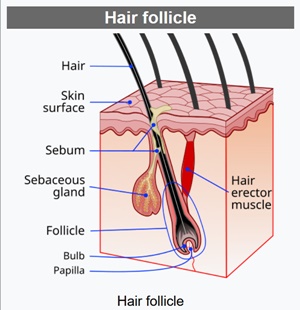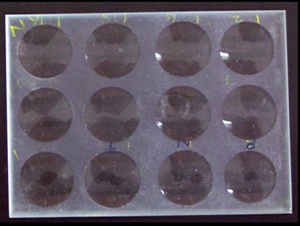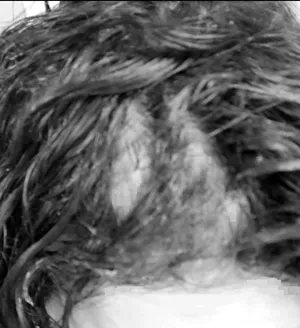
Getting To The Root Of Women's Hair Loss
 National Cancer Institute - Male Lab Technician in 1950
National Cancer Institute - Male Lab Technician in 1950Women's hair loss isn't always as easy to diagnose as it is in men.
The vast majority of hair loss in men is genetically triggered. It's caused by androgentic alopecia (AGA).
The same is not true with women's hair loss. There are myriad of causes and conditions which may trigger hair loss in females.
When it comes to women's hair loss, the best way to manage it is to get a baseline diagnosis as soon as hair starts to shed.
 Image - Olga Guryanova - Unsplash.com
Image - Olga Guryanova - Unsplash.comThe Best Way to Manage Women's Hair Loss Is With A Baseline Diagnosis
Knowledge is power. Once a diagnosis is available, it's possible to plan the appropriate treatment plans.
No two hair loss physicians will follow the same diagnostic testing protocols. Hair loss physicians usually have a series of diagnostic tests they favor.
Physicians Utilize A Variety Of Different Tests
 Microscope Used in Lab Test - Unsplash.com
Microscope Used in Lab Test - Unsplash.comPhysicians will run the most comprehensive tests for the benefit of their patients.
Not all physicians will run all of the tests listed. Some will run many, but maybe not all the tests.
Determining the root cause of female hair loss usually starts with the elimination process.
Many, but not all, hair restoration physicians will start their analysis with the following tests:
1. Conducting a complete family history.
This will help determine genetic predisposition. It'sadvantageouss when new patients provide as many hair loss details as possible.
 Hair Follicle - National Institutes of Health - Wikipedia
Hair Follicle - National Institutes of Health - Wikipedia2. Performing visual examinations of the patient's scalp, roots, and hair follicles.
Many hair loss physicians will do a visual examination based on the Ludwig scale.3. Complete blood count panel (CBC).
A complete blood count (CBC) is a blood test. It's used to evaluate overall health. Also, it detects a wide range of disorders.This includes anemia, infection, and leukemia. Additionally, the physician may test B12 and D levels.
4. Blood tests to measure T3, T4 and TSH thyroid levels.
Thyroid function tests are a series of blood tests. They're used to measure the thyroid glands functionally. Tests include T3, T3RU, T4, and TSH.5. Hormone-level testing.
 Physician - Unsplash.com
Physician - Unsplash.comSex hormonal panels to help isolate the cause of hair loss would include the following tests:
- Differential and Platelets
- Comprehensive Metabolic Panel (CMP)
- DHEA-S
- Dihydrotestosterone (DHT), LC/MS/MS
- Follicle-stimulating hormone (FSH)
- Estradiol
- Estrone, LC/MS/MS
- Progesterone, Immunoassay
- Testosterone, Free and Total
6. Testing of iron levels.
This includes serum iron, serum ferritin, and total iron binding capacity (TIBC).7. VDRL screening for syphilis.
 VDRL slide used in VDRL test - Microrao - Own work
VDRL slide used in VDRL test - Microrao - Own workBlood is drawn from a vein (venipuncture). It's usually from the inside of the elbow or back of the hand.
An RPR (rapid plasma reagin) is usually run as well. It's a screening test for syphilis.
8. Evaluation of hair shaft miniaturization.
A handheld magnification device is used. It's known as a densitometer.9. Scalp biopsy.
A small section of the scalp is removed. It's examined under a microscope. This helps determine hair loss causes.10. Hair pull test.
A small amount of hair (around 100 strands) is pulled from the scalp. If more than three hairs can be pulled, excessive hair loss is a concern. The normal range is one to three hairs per pull.Ludwig And Savin Scales
Hair restoration physicians may also refer to the two widely known female hair loss density scales. They include the Ludwig Scale and the Savin Scale. They are identical, except that the Savin Scale also measures overall thinning.Diagnostic Tests Should Be Performed To Pinpoint Hair Loss Trigger
 Medical Doctor - HB Media - All Rights Reserved
Medical Doctor - HB Media - All Rights ReservedAll diagnostic tests are performed to pinpoint hair loss causes. Unfortunately, some of the tests may produce normal readings.
At least different tests may eliminate certain disorder possibilities for hair loss.
Polarized Light Microscopy + HairMetrix® And Trichotest®
Some of the newest, most effective AI-powered hair analysis systems aimed at preserving and restoring hair is utilized by hair loss pioneer Dr. Alan Bauman.Polarized Light Microscopy (PLM) is a diagnostic tool that allows Dr. Bauman to diagnose specific hair and scalp problems.
Besides the PLM, he also is the first to use HairMetrix®. It's the first Artificial Intelligence (AI)-driven non-invasive hair measurement tool for consultations, follow-ups, and clinical hair growth research.
 Dr. William C. Hueper looking through a microscope in the pathology department, Central Cancer Research Laboratory, Graduate School of Medicine, University of Pennsylvania.
Dr. William C. Hueper looking through a microscope in the pathology department, Central Cancer Research Laboratory, Graduate School of Medicine, University of Pennsylvania.Dr. Bauman also employs Trichotest® Genetic Hair Loss Testing. The test uses state-of-the-art DNA microarray technology.
It identifies the exact hair loss treatments that will perform best for the patient. It's based on DNA analysis.
Trichotest®
Trichotest® examines DNA from patient saliva. It also measures details of the patient's lifestyle. It analyzes a total of 48 genetic variations. It elucidates all unique metabolic pathways influencing hair loss.
Trichotest® uses scientifically validated global research. Hair restoration experts are enabled to make informed recommendations. They can offer the most ideal FDA-approved, off-label, or non-pharmaceutical options.
 TrichoTest™ analyzes both genetic factors and other relevant characteristics.
TrichoTest™ analyzes both genetic factors and other relevant characteristics.These are based on the patient's unique DNA. It uses a Personalized Precision Medicine approach. It achieves faster, better hair growth results. It also saves patients time and money.
HairMetrix®
Based on a machine-learning algorithm, the HairMetrix® system provides real-time analysis of hair density, hair caliber, and other metrics without needing any hair trimming.
 DNA Genotyping and Sequencing - Unsplash.com
DNA Genotyping and Sequencing - Unsplash.comThis contributes vital information to a Hair Restoration Physician and their patient.
It allows them to compare more permanent areas of hair growth to weaker zones.
HairMetrix® allows for the precise tracking of timely hair growth results.
The test works by comparing future measurements to the initial baseline. Patients can see how well hair loss treatments work.
 Hair Loss Medications - Unsplash.com
Hair Loss Medications - Unsplash.comDr. Bauman is one of the first physicians worldwide to use this new AI-powered hair analysis system.
Summary - Getting To The Root Of Women's Hair Loss
The best way to get to the root of women's hair loss is to have testing done. This will hopefully provide a core diagnosis.Although Androgenetic Alopecia (AGA) is the most common type of women's, there are other types of alopecia.
Early diagnosis can make all the difference in long-term hair loss management. Once you have a baseline diagnosis, you can plan the proper short and long-term treatment.
Best wishes to all.Social Media Network Information
Please follow us on Twitter at: https://Twitter.com/HairBoutique. I look forward to meeting new people from all walks of Twitter and learning from their Tweets.
















